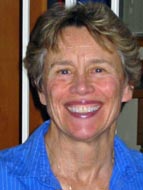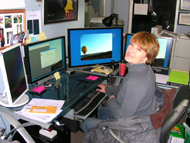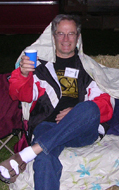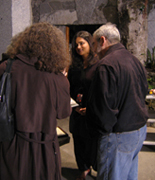- Details
-
Created: Friday, 02 March 2007 05:31
We, as editors, thought you might like to know a little bit about what goes into putting together this miracle known as Sculpture NorthWest that appears in your mail every couple of months. Not that we’re saying that the Journal itself is miraculous (although if you were to say so, we would be happy), but rather that it is a miracle that a handful of people manage to pull together all of the interesting bits of information and technology into the fascinating 16 pages that you now hold in your hand. This is a glimpse of what keeps the Staff out of pool halls in order to put together another new copy every sixty days.
First, let’s meet the production staff; in alphabetical order they are: Debbie Asavarahapun Record keeper, Penelope Crittenden Co-editor, Nannette Davis Printer, Adele Eustis Graphic Artist, Lane Tompkins Co-editor.
Not on the list, but indispensable are the many NWSSA member contributors. The Journal wouldn’t be what it is without them. Thank you every one who has contributed in the past, who currently contributes and who, even as they read this might be saying: “I have an idea for an article they might like.” Keep ‘em coming!
Before you receive your copy of Sculpture NorthWest, this small group of people have spent weeks doing chores that never seem to end. Those chores are many and diverse. We email, we make phone calls, we write, proofread, layout and print. There are pictures to receive, select, crop and arrange. There are members to solicit (albeit in a charming way) for articles. Computer files are created and adjusted. Aluminum sheets, digital film, ink and rubber are carefully handled. Facts are checked and discussed and rechecked. There are sentences to rearrange, spelling to correct, and paragraphs to be shortened or made longer. And there are the sensibilities of the membership as a whole to consider.
Now let’s take a look at each member of our production staff and what they do between every issue. We’ll start with the co-editors.

Lane Tompkins and Penelope Crittenden
Lane, from Creswell, Oregon came to the Journal a little over four years ago. He and Terry Slaton took over the helm together. They struggled a bit at first, but finally got the hang of their jobs, and the years went by.
With Terry’s retirement, after years of dedicated work (thank you, Terry), Penelope returned for another time at the editorial bat, this time from her new location on Lummi Island. Together, she and Lane share the editorial hat. No matter how the editors divide the work or what titles they give themselves, there is a heck of a lot to do and they try to help each other as best they can. They solicit and gather articles, write new ones, proof, edit and are responsible for generating, one way or another, about seven thousand words every sixty days. It can be a daunting task, particularly during times when they find themselves looking at sixteen pages of blank paper and not a clue as to what might go on those pages. So off they go to gather fresh, interesting, informative and readable articles and interviews.
Once Lane and Penelope have gotten enough material to fill up sixteen pages, they put it all on a single sheet word document inventory. Then they gather photos, come up with captions and send the whole fascinating, yet visually uninteresting kit and caboodle to the Graphic Artist.
Adele Eustis
Adele’s office is in her Seattle, Washington home. This is where words and visuals come together to be transformed into the stylish and professional looking magazine that you have come to know and love. Adele is good at her job. Adele gives us An Image. She is a paid employee and earns every penny for her artistic expertise. In addition to her talent, she uses special computer software to do the text and picture arranging, generating of new graphics and designing a best fit for it all.
Every thing she receives from the editors she puts into a PDF file, short for Portable Document Format and then sends the PDF back to the editors to be proofed again. Changes are put on small pop-up notes for Adele to read and incorporate into the PDF which is then sent back to the Editors for another proofing. It will sometimes go through several incarnations before everyone is satisfied.
This new, ‘perfect’ PDF (Okay, occasionally we miss something) now goes to our printer.

Nannette Davis
PrintCore is the name of a small shop in Woodinville, Washington. It came into being three years ago when Nannette Davis decided to leave Minuteman Press and strike out on her own. She had for years been the Minuteman employee who printed the Journal, and so it was a natural to stay with us and we with her in her new role as employee/owner of the fledgling PrintCore. Nannette knows her business well and is always willing to go the extra mile.
With the PDF in hand, digitally speaking, Nannette makes a copy on her graphics computer, which she sends to the editors. If it looks good, and it almost always does, she gets the word to ‘start the presses.’ That means that through offset printing, using aluminum plates and rubber sheets, all the unseeable digital bytes are finally turned into hard copy pages to be collated, trimmed and stapled. We are presently printing about three hundred copies for mailing to our members and selected businesses that will mention NWSSA to their customers.
Nannette also handles the bulk mailing of about two hundred fifty copies: sticking on the labels and closure tabs, sorting by zip code and delivering them to the Post Office in Woodinville.
Debbie Asavarahapun
Debbie Asavarahapun takes care of the twenty five copies that are sent as first class and to international addresses: putting on the closure tabs and stamps, and dropping them off at the Lake City post office in Seattle. Debbie also keeps back twenty five, sending each contributor four Journals and keeping the remainder on hand for posterity.

She also keeps track of the NWSSA membership roster, and manages the accounts receivable for our back cover ads.
Well, now you know a little bit about who we are and how the Journal is made. But let us not forget about that most important part of the story - the day your copy of Sculpture NorthWest arrives in the mail. Sit down, pour a favorite beverage, put up your feet and enjoy.
All of us on the Journal staff hope that you do enjoy each and every issue. It is our aim to inform you about stone sculpture and related happenings. We try to do that with ample measures of wit and grace, and we welcome your opinions on all that we do. Let us know if we are giving you what you want on the sixteen pages that - when all is said and done - belong to you.
 Clean alabaster dust from your rasps and files. It attracts moisture: your tools can rust in the toolbox.
Clean alabaster dust from your rasps and files. It attracts moisture: your tools can rust in the toolbox.
 For two weeks in February, we in the Seattle area had the unique opportunity to host the sculptor Humaira Abid. Through her slide shows and presentations we had a chance to enjoy photos of her work and to hear stories of what it is like being the only full time practicing female sculptor in Pakistan.
For two weeks in February, we in the Seattle area had the unique opportunity to host the sculptor Humaira Abid. Through her slide shows and presentations we had a chance to enjoy photos of her work and to hear stories of what it is like being the only full time practicing female sculptor in Pakistan.




